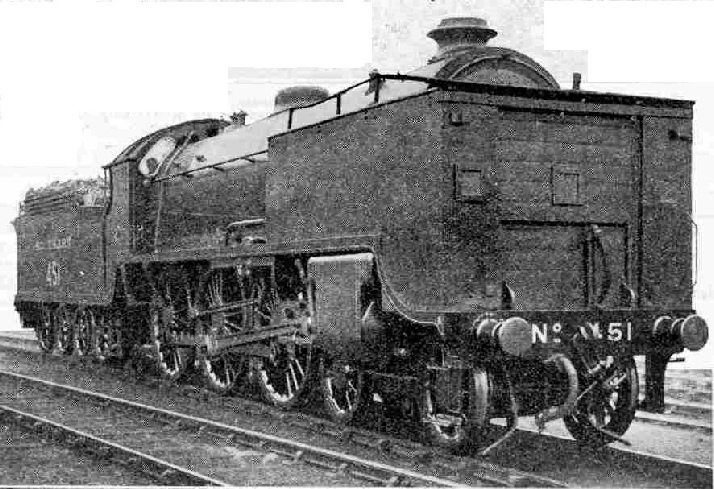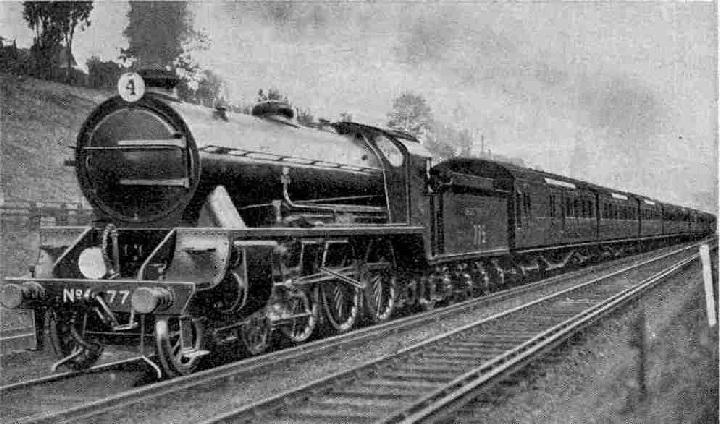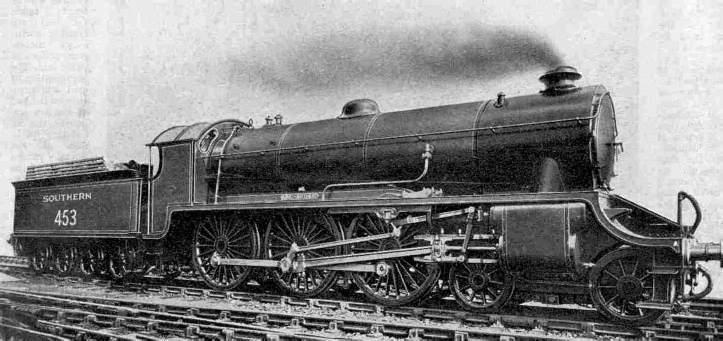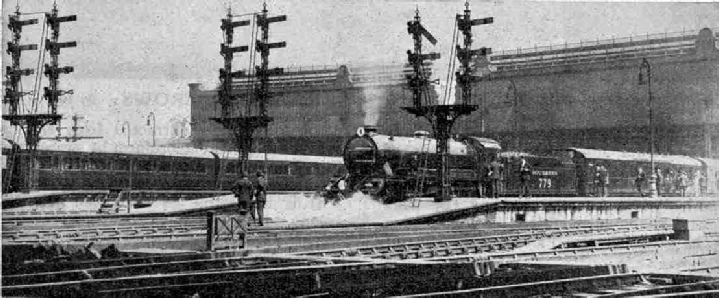A Famous Train of the Southern Railway
FAMOUS TRAINS - 13A

“King Arthur” class 4-6-0 engine “Sir Lamorak” equipped with indicating shelter for experimental running on the “Atlantic Coast Express” between Waterloo and Salisbury.
ALTHOUGH the famous express leaving Waterloo at eleven o’clock in the morning can look back on a long history - much longer, indeed, than that of the rival “Cornish Riviera Limited” express out of Paddington - it is barely for a year past that it has enjoyed the dignity of a name. It is an excellent name, too. “Atlantic Coast Express” aptly sums up the fact that this train, ere its journey is done, will have distributed parts of itself over much of the coast washed by the mighty Atlantic Ocean, both north and south of Devon and in North Cornwall as well.
We may well pause for a look at Waterloo terminus before we pass through the barrier to our train. Waterloo, once the most awkward and inconvenient of all London termini, an invariable topic for comic papers, a “maze” where one might hunt for a long, long time before running the right train to earth - Waterloo has now developed into the biggest and finest of all our stations.
It was the fact that so many additions had been tacked on to the original Waterloo - four in all since the first opening in 1848 - that made it such a labyrinth in days gone by. Now, by a marvellous feat of engineering, the new station has been built round and over the original, without any interruption of its enormous traffic.
Apart from the arresting frontage of the station, its most remarkable feature is the vast “concourse”, or circulating space for passengers, which extends almost across the whole width of the station. At the back of this are the offices, and at the opposite side the platform entrances. The old station on the Windsor side - the most recent of all the “additions” to the original Waterloo, opened in 1912 - was really the first instalment of the new Waterloo, and so has been left in its existing condition. This portion has six platforms. The rest of the station, covered by one lofty “ridge and furrow” glass roof right across from one side to the other, has 15 platforms, making a total of 21 in all. Both in this respect and in respect of its covered area of 24½ acres, Waterloo holds the record for British stations. Every day it handles just under 1,200 passenger trains in the 24 hours.
Now let us pass through on to our platform. During the height of the summer, the traffic to the coast is so heavy that one “Atlantic Coast Express” can far from provide room for all those who desire to travel by it. Two trains are then run daily, except on Saturdays, when the number swells to five or even six in all. But as we are at present in the spring of the year, we shall find every one of the destinations of this famous “flier” served by one striking assemblage of vehicles. First to leave us are the two rear coaches, the hindmost labelled “Sidmouth” and the next one “Exmouth”, although we shall travel 159½ miles together - to Sidmouth Junction - before parting company.
The big break-up of the train takes place at Exeter. Third coach from the rear we find the restaurant car, which is detached at Exeter; and next to that come in succession coaches for Bude, Padstow and Plymouth, which are going on together as far as Okehampton, high up on the slopes of Dartmoor. Then we find a coach for Torrington and, last of all, next to the engine, the real “body” of the train - three coaches destined for Ilfracombe. The Ilfracombe and Torrington portions will journey along together as far as Barnstaple. So the complete train consists of eight parts, respectively for Ilfracombe, Torrington, Plymouth, Padstow, Bude, Exeter, Exmouth and Sidmouth.
Probably all the coaches will be of the latest steel-panelled bogie stock, in its handsome green livery. The Ilfracombe portion is made up of two third-class brakes and a first and third class “composite”; all the others,, save the restaurant car, are “composite brakes” - that is to say, coaches with four third-class and two first-class compartments, and a small guard’s brake. A singular result of such a formation as this is the exceptional amount of first-class accommodation. One smoking and one non-smoking first must be provided in each portion, so that there are nearly half as many first-class as third-class compartments, which makes the travel exceptionally comfortable for the first-class people. These are heavy coaches. The composites weigh 32 tons each and the third brakes 30 tons, so that, inclusive of the 36-ton restaurant car, the 10-coach train turns the scale at 320 tons. With a normal complement of passengers and luggage, the engine may be expected to have a load behind him of 335 to 340 tons; but in summer the loads are often round about the 400-ton mark.
We need be in little doubt as to what type of locomotive we shall find at the head of the train. We may be fortunate enough, of course, to run across the new 4-cylinder 4-6-0 giant, “Lord Nelson”, but he is at present the only one of his type, and as he is engaged in making the experimental runs over various parts of the Southern system, it is a hundred to one that our engine will be one of the well-known “King Arthur” type. And who could be better suited to whirling us away to the “King Arthur” country than one of the “Knights of the Round Table”?
It is difficult to lay one’s finger on the precise secret of the success of these remarkable engines. Almost every week, in connection with my series of articles in the “Railway Magazine” entitled “British Locomotive Practice and Performance”, I receive from readers who have been using their watches while travelling some new record of “King Arthur” performance. Maximum speeds of 90 miles an hour; sustained speeds of 65 to 70 miles an hour over long sections of favourable track; splendid hill-climbing up the heavy grades of the West Country, whose acquaintance we shall make in a moment - nothing seems to come amiss to them.
In one very important respect their designer, Mr. Maunsell, who has developed them from the general lines of the previous 736-755 series, designed by Mr. Urie, has followed Great Western practice; and that is in the use of a long travel for the piston-valves, which has a vital bearing on the work of the engines, as it enables them to be run with a wide-open regulator and a short cut-off, as Great Western drivers are so fond of doing. And rightly, for it is the most efficient way in which they could possibly use their steam, provided that the engine has been designed in such a manner as to respond to the treat-ment.
Beyond this the “King Arthur” is not an enormously big engine, as our modern engines go, nor, do the two 20½-in by 28-in cylinders give - on paper - a very high tractive effort. But the axiom in locomotive work is “handsome is as handsome does”, and this certainly describes “King Arthur” performance.
Well, the time has now undoubtedly come to start, and we must therefore take our places in the train. Out of Waterloo, where there is for a short distance a fairly steep rising gradient, the engine which brought in our empty coaches will probably assist us by a friendly push in the rear, but will not venture much further out than the end of the platform. Our speed will then rise fairly rapidly until, at the bottom of the slight dip between Vauxhall and Clapham Junction, we may expect to be travelling at 50 miles an hour, or slightly over. As the Brighton section from Victoria flies over our heads and then comes down to join us on our left, we cannot fail to be impressed with the enormous width of parallel trackage. So far as parallel running lines are concerned, apart from sidings, there are probably more here than anywhere else in the country.
Seven minutes after our exit from Waterloo we are through Clapham Junction, where the Brighton main line bears away from us on the left, after thus keeping us company for about a mile. Clapham Junction is, without any question, the busiest station in Great Britain and probably in the world. It has 17 platforms, covers 24¼ acres, or if all the sidings be included, 34¾ acres, and deals with no less than 1,730 trains every 24 hours. The majority of these are now electrically operated, by the third-rail system on the South Western side of the station and by the overhead system on the Brighton side.

Down “Atlantic Coast Express” in Clapham Cutting, Southern Railway. 4-6-0 engine No. 775 “Sir Agravaine”, of the “King Arthur” class with latest type of cab and tender.
For the first 20½ miles of its journey our “King Arthur” locomotive has a fairly level route to traverse. The line rises on modest gradients from Clapham to Wimbledon, is dead level from there to beyond Surbiton, whence it falls slightly past Hampton Court Junction to Esher; on this fall we may expect an increase of speed well above the “sixty” line to about 67 or so an hour. To the junction, 134 miles out of Waterloo, we are allowed 18½ min. in the working time-table, the precision of the odd half-minute being necessary in order to fit the expresses in with the very frequent electric trains.
We may notice here how the Hampton Court down line is carried over the main line by a “flying” junction, so obviating the obstruction that would be caused had the Hampton Court trains to cross on the level the up and clown main lines, and the up slow line as well. You see the same principle operating at the junctions at Raynes Park, Malden, Byfleet, Pirbright, Sturt Lane and Worting, the layout of all of which helps to prevent the expresses from getting delayed by signal checks.
By now we are descending the 1¼ miles past Weybridge to Byfleet Junction, and are probably doing 67 or 68 miles an hour.
The driver would tell you, in his own expressive language, that the engine is “getting hold of ‘em”, which is just as well, for directly we have skirted on the left the Brooklands motor track - and very likely have done a “neck-and-neck” for half-a-mile or so with some racing car that is being tried out - our “King Arthur” is faced with some hard work.
For the next 32 miles, indeed, there is very little intermission in the climbing. Not that it is steep; the 10½ miles from Byfleet Junction to mile-post 31 steepen gradually from 1 in 388 to 1 in 298; then, after six miles level past Farnborough and Fleet, come three miles up at 1 in 337 to Winchfield; then six miles more level or slightly undulating bring us to the five miles up at 1 in 249 past Basingstoke to Worting Junction, where we part company with the Southampton and Bournemouth line.
These are not heavy grades, as I have said, but we must remember , that our locomotive is scheduled to run up them at an average speed of nearly 56 m.p.h. - from Woking to Worting - which means uninterrupted hard work, or “collar-work”, as it is sometimes called, to borrow for the iron horse a metaphor from his flesh-and-blood brother on the roads.
By Woking speed will have, dropped to 60 miles an hour. We have now covered 24½ miles from Waterloo in 29 minutes. Between here and Basingstoke we notice, for a distance of over 20 miles, a stretch of entirely automatic signalling. The signals are carried on lattice girder bridges over all four lines, and by electro-pneumatic mechanism are worked by the trains themselves, except of course, at the junctions and stations, where the points are operated from signal-boxes. By automatic signalling it is possible to work high-speed trains at very close intervals.
This is, in fact, one of the fastest stretches on the Southern system, the up expresses, in certain cases, being only allowed 21½ min. to cover the 23½ miles between Basingstoke and Woking, and not infrequently covering the distance in under 20 minutes. On the inaugural up-run of “Lord Nelson”, described in the article “Britain’s Most Powerful Loco”, you will see that the time over this “galloping ground” was five seconds over 19 minutes.
We shall probably breast the miniature “summit” at mile-post 31 at round about 50 miles an hour, and from Farnborough nearly to Basingstoke we shall run at sixty, or slightly over. The booked time to Basingstoke, 48 miles, is 54 minutes and three minutes later we should be past Worting Junction, 50½ miles out, at the summit point of our climbing and the end of the engine’s hardest efforts. For after Oakley, a couple of miles farther on, the line falls, gently at first, but quite steeply at last, for the next 13 miles. Were we on the footplate we should now see the cut-off brought well back and the regulator partly closed.
From a minimum rate of 47 m.p.h. or so at Worting our acceleration at first will be relatively slow, but by the time we pass Overton - where the paper for Bank of England notes is made at the big factory on the right of the line - we shall be doing 60 an hour and more. Through Hurstbourne we dash at well over 70 and then, after negotiating a short rise, the 1 in 178 down to near Andover will quite likely witness the first 80-mile-an-hour maximum of our journey, if the driver be so minded.
The impetus of this swift flight will help to carry us up the seven steeply-rising miles to Grateley, finishing with 2¾ at 1 in 165 and bringing the speed down to about 50 an hour again. Then follows a glorious downward spin through the heart of the Wiltshire Downs, with the slender spire of Salisbury Cathedral in sight dead ahead again we may touch a top speed anywhere between 75 and 80 miles an hour - until we thread a short tunnel and draw up at Salisbury platform.

The Southern Railway 4-6-0 engine “King Arthur” which gave its name to the class.
For the 83½ miles from Waterloo the time-table shows exactly an hour-and-a-half, but “King Arthur” drivers are very fond of lopping minutes off this schedule, and quite likely we shall have taken 89 or 88 minutes, or even less. On one experimental run not so very long ago the engine “Sir Lamorak”, which figures in one of my illustrations, succeeded in cutting the time to 75 minutes, which was a very remarkable achievement. But this is really a secret, and ought not to be spoken about above a whisper!
At Salisbury we shall probably lose our London “King Arthur” and get another for the next 88-mile stage of our journey to Exeter. In the summer, however, the engines sometimes work right through, although the engine crews are changed at Salisbury.
The switch-back over which we have just come during the last 25 miles of our journey is a foreshadowing of the far steeper switchback ahead of us. Higher average speeds are run over the Salisbury-Exeter length of the Southern, in proportion to the severity of the gradients covered, than could be instanced on any other railway in the world, in all probability. Although there are long stretches of 1 in 80, yet the average booked speed of the “Atlantic Coast Express” from Exeter to Salisbury, during the summer months, is no less than 55 m.p.h, and but a shade less in our direction of running. In the winter there is an additional stop to make at Sidmouth Junction, but the speed to that point is just as high.
These average speeds are only made possible because of the splendid lay-out of this route, which permits of practically unlimited downhill speeds, and the latter are in their turn of material assistance to the engines in climbing the uphill grades. Thus we may look out, not only for one or two, but for more like half-a-dozen very high maxima, at certain well-defined places.
Out of Salisbury we climb, gradually at first but then more steeply, for 17½ miles to Semley, only the final two being as steep as 1 in 145. Then, suddenly, as though we were dropping down the roof of a house, there comes a thrilling speed-up down to Gillingham, out speed rising in four miles probably to the “eighty” mark. Two miles’ ascent to Gillingham Tunnel, and we drop again sharply to Abbey Ford. Then comes Templecombe bank - with a mile at 1 in 80 and 1½ in 160 - which will bring us down to between 45 and 40 an hour. A short “plateau” past Milborne Port, and there follows another hurricane descent into Sherborne, with a second “eighty”, very likely.
From here we shall traverse 5½ miles of undulations to Yeovil Junction at high speed, the 39 miles from Salisbury to this point having taken us about 44 or 45 minutes. Sutton Bingham bank - 3½ miles up at between 1 in 220 and 140 - now lies ahead, with some subsequent moderate downhill stretches that bring us to the foot of Crewkerne bank. This is very severe, being for 2¾ miles at 1 in 80, and when we have threaded the short tunnel near its summit, our speed will not be much over 30 miles an hour, perhaps 32 or 33.
But from Hewish onward is one of the most glorious “racing grounds” of the journey - 13 miles of uninterrupted downhill, not excessively steep, past Chard Junction and Axminster. The major part of tills we shall cover at a speed well above 70 miles an hour, while the driver is at the same time getting his boiler filled up and a good head of steam in preparation for the hardest task the engine has yet faced.
This begins rather less than two miles beyond Axminster, Here the line makes a right-angled turn, from a south-westerly to a north-westerly course, up into the hills, to get through to Honiton. This entails a climb, first of 1¾ miles at 1 in 100 to Seaton Junction, and then of 1 in 80 for no less than 4½ miles, to the Honiton Tunnel, which bores under the crest of the watershed for ¾-mile, the railway still rising at 1 in 132. Actually, in seven miles, the line climbs rather over 400 ft. To go over this summit at a minimum rate of 30 m.p.h. with this load would be a miracle; we may expect a minimum of from 23 to 25 miles an hour, if the weather is good and the rails are not greasy.
Once through the summit tunnel, our “King Arthur” has no further troubles to face. In the summer, when the 11 a.m. from Waterloo makes no stop at Sidmouth Junction, less minutes will probably be taken from Honiton into Exeter than the miles
covered. On my last journey but one the locomotive “Elaine” touched 85 miles an hour on this descent, but the same engine beat this record in the same week by taking me down the other side of Honiton at a top speed of exactly 90 an hour!
Even in the sharp dip before Sidmouth Junction, however, we may and probably shall get high up into the “seventies”, possibly even to 80; and then, after leaving the junction with a trainload less by two coaches, we may expect a final “burst” of 75 to 78 m.p.h. through Broad Clyst. So, after these thrilling experiences, we draw up at Queen Street, Exeter, 171½ miles from Waterloo, at 2.22 p.m. The fastest time in the summer, of the Ilfracombe portion of the train, is 3 hours 13 minutes to Exeter, inclusive of a six minute stop at Salisbury.
As our “Atlantic Coast Express” now breaks up into various parts, we will bid it a reluctant farewell. The Plymouth, Padstow and Bude coaches are going to climb high up the slopes of Dartmoor; beyond Meldon Junction, Okehampton, the first-mentioned of the three will, indeed, go over an altitude of 950 ft, ere it drops to Tavistock and thence into the Tamar valley, so reaching Devonport and Plymouth. Just before Meldon Junction, by the way, is the remarkable lattice girder viaduct.
Immediately after the various portions of the train leave Queen Street Station at Exeter, they have to descend the steepest gradient on the whole of the main line. It is only ½-mile long, but the steepness is 1 in 37; it leads down through a short tunnel on to the Great Western main line at St. David’s Station, and Great Western metals are used for the next 1¼ miles to Cowley Bridge Junction. In view of the tremendously steep incline just mentioned, all up Southern trains, the “Atlantic Coast Express” included, have to be banked in rear from St. David’s up to Queen Street, the heavier of them by two 0-6-0 tank engines coupled together.
In this connection it is a singular thing that as in St. David’s Station at Exeter - the next stop - the Southern train from Waterloo comes in at the south end of the station and the Great Western train from Paddington at the north end, so at North Road Station at Plymouth the same Southern train arrives from the west and the same Great Western train from the east! That is to say, twice in journeys in the same direction between the same places these two trains can meet each other, in both cases running in opposite directions!
The Ilfracombe and Torrington portions make off up the fertile valley of the Taw to Barnstaple, where they separate. What the Ilfracombe train does not attain in the matter of height, as compared with its Plymouth and Padstow associates, it certainly makes up for in the matter of gradient, for beyond Barnstaple it has to climb at 1 in 40 between Braunton and Mortehoe, finally dropping down to the “Atlantic Coast” at Ilfracombe by a two mile gradient at 1 in 36!
So another day’s travel of the “Atlantic Coast Express” is brought successfully to a conclusion.

The “Atlantic Coast Express” (first portion) leaving Waterloo for North Cornwall on its first trip, July 19th. The second portion (Ilfracombe) is in background, by No. 11 Platform.
You can read more on “The Atlantic Coast Express”, “The Story of the Southern” and “The Thirties, Southern Railway” on this website.






